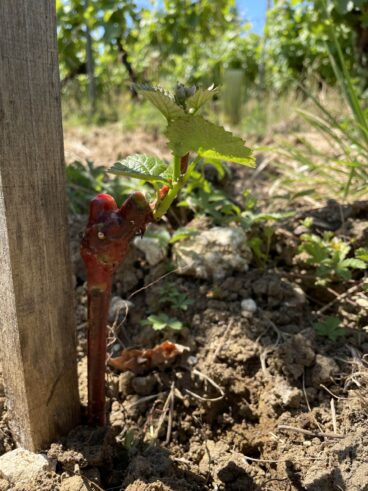The estate
KALIAN, with a vineyard of 13.8 hectares, is located 10 km south of Bergerac, on the left bank of the Dordogne.
The different vineyard blocks are located within the AOP MONBAZILLAC: both in the commune of Monbazillac (75%) and in the commune of Rouffignac-de-Sigoulès (25%).
A variety of terroirs
The final complexity of KALIAN wines is largely due to the variety of soils on the estate.

The Bernasse and Petit Malfourat vineyards are established on well-aerated and porous soils,
precocious and with high potential for all types of production.
The soils of these vineyards consist of:
- clayey Calcosols of varying thickness on hard limestone, more commonly known as “hillside clay-limestone soil” (representing 60% of the soils of KALIAN);
- Calcisols on sandy calcic molasse mixed with thick vertical Calcisols (representing 7% of KALIAN soils).
The l’Envège vineyard is made up of thick redoxic Luvisols, more or less resaturated, more commonly known as "Boulbène on decarbonated molasse" (representing 7% of KALIAN soils).
This type of medium-late soil is particularly interesting for the production of sweet wines.
Finally, the Rouffignac-de-Sigoulès vineyard is made up of truncated Luvisols on decarbonated molasse (“Boulbènes” type, representing 16% of the soils of KALIAN) and more or less thick clayey Calcosols on hard limestone (“hillside clay-limestone soil” type, representing the last 10% of KALIAN soils).
A particularity of the Rouffignac vineyard block is the presence, below, of springs allowing for good
drainage of the vineyard, thus avoiding stagnant humidity.

The vineyard
Since the creation of the estate in 1992, different phases of expansion have followed one another, creating a vineyard where a strong diversity of age, grape variety, rootstock and exposure coexists.
We have sought to keep as many old vines as possible in order to maintain a diversity of Sémillon and Muscadelle grape varieties (which were originally present on the property) and to guarantee the sustainability of the vineyard. Thus, nearly 60% of the white vineyard is represented by vines older than 50 years.
Following this mindset, the old vineyard blocks are co-planted (replacement of dead vines) as much as
possible with young vines produced from budwood selected on the estate’s old vines in winter during the pruning season ("massal selection”).
In 2019, a new block of Muscadelle was planted entirely from the budwood of 65-year-old Muscadelle vines present on the estate.


Following the topography of the vineyard, the exposure of the vines is 90% EAST-WEST. Only the l’Envège vineyard and a block in Bernasse are oriented NORTH-SOUTH.
The altitude of the different vineyard blocks varies little: from 140 to just over 160 meters.
The KALIAN vineyard is mainly white (79% of KALIAN’s vineyard) with 4 different grape varieties:
- 78% Sémillon Blanc,
- 15% Sauvignon Blanc,
- 6% Muscadelle and
- 1% Chenin Blanc.
Read more about the white grape varieties of KALIAN
The red vineyard, for its part, represents 21% of the property and the grape varieties are:
- 75% Merlot Noir,
- 16% Cabernet Franc and
- 9% Cabernet Sauvignon.
A favorable microclimate
Located about a hundred kilometers from the Atlantic Ocean, the Monbazillac appellation experiences an oceanic climate combined with a fairly marked continental influence.

Winters are generally short and rarely harsh. Rainfall is abundant in the spring, making the development of the vines favorable. Summers can be relatively hot while autumns are often long and sunny until mid-November, which generally allows harvesting in good conditions and with good maturity of the grapes.
The Monbazillacois can also take advantage of a particular microclimate that gives it an unparalleled advantage for the production of sweet wines. The autumn is characterized by frequent morning fog (in part due to the proximity of the Dordogne river) followed by sunny days, favorable to the development of a microscopic fungus, Botrytis cinerea, or “noble rot”.
Botrytis cinerea is the essential actor in the production of Monbazillac. The grapes are harvested “noble-rotten”: the berries are purplish, wrinkled, dried out and covered with a whitish down, that looks like ash (hence the name “Botrytis cinerea” which means “ashy bunch”).
However, this rot is only truly "noble" under certain conditions: complete ripeness of the grapes (which happens around mid-September) and the ideal climatic balance: not too dry because otherwise sporulation would stop, nor too wet because the concentration of sugar would cease.
